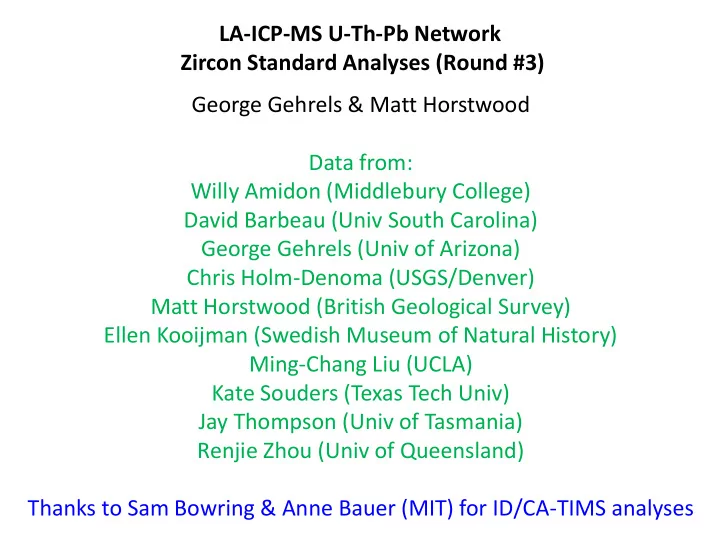

LA-ICP-MS U-Th-Pb Network Zircon Standard Analyses (Round #3) George Gehrels & Matt Horstwood Data from: Willy Amidon (Middlebury College) David Barbeau (Univ South Carolina) George Gehrels (Univ of Arizona) Chris Holm-Denoma (USGS/Denver) Matt Horstwood (British Geological Survey) Ellen Kooijman (Swedish Museum of Natural History) Ming-Chang Liu (UCLA) Kate Souders (Texas Tech Univ) Jay Thompson (Univ of Tasmania) Renjie Zhou (Univ of Queensland) Thanks to Sam Bowring & Anne Bauer (MIT) for ID/CA-TIMS analyses
Plesovice = 337 Ma Seiland (Sri Lanka) = 531 Ma FC-1 = 1099 Ma Sample were blind, grains were mixed 17 labs submitted data (Lab names not reported) ==> Most 206/238 & 206/207 ages reliable to ~2% Presented at AGU and 2009 Workshop, manuscript not submitted
Round #2: Interlab Comparison (2011-2013)
VC 1-2 = 213 Ma Plesovice = 337 Ma Seiland (Sri Lanka) = 531 Ma FC-Z5 = 1099 Ma 9980 = 1150 Ma QGNG = 1852 Ma Blind samples, abraded grains, uncertain # of populations, uncertain proportions 208 grains provided ==> analyze 100 grains at random 10 labs submitted data (8 LA-ICPMS, 2 SIMS) (Lab names not reported) Evaluate ages & proportions
213 Ma 337 Ma 1099 Ma 531 Ma 1150 Ma 1852 Ma
213 Ma 337 Ma 1099 Ma 531 Ma 1852 Ma 1150 Ma
LA-ICP-MS U-Th-Pb Network Meeting in 2013 decided to do another comparison: more standards, expanded age range, more labs
10 different standards from 28 Ma to 3.5 Ga Hired UA undergraduate students to pick grains from each standard: • 10 different standards • 100 grains of each • 100 sets ==> 100,000 grains picked! Have distributed sets to 68 different labs (some up to four sets!!) Have so far received data from 11 labs…..
Matt's Instructions: • 10 analyses of each standard (cycle thru 10 times, not in sets) • Use 91500 as primary (or provide 91500 results for re-calculation)* • Report weighted mean ratios and ages (no rejection)* Report systematic (external) uncertainties (2 s )* • Decisions about data analysis & display • Which of the above are important variables? • Focus on ages or ratios? • Compare results with ID-TIMS or CA-TIMS data? • Report Internal (measurement) or Internal + External (systematic) uncertainties? • Show all sessions from each lab or average of sessions if more than one?
Look at correlations with Uconc & Radiation Dosage
Look at correlations with Uconc & Radiation Dosage
Conclusions: 1. Need more data to reach firm conclusions... 2. Doing better than 2% for 206/238? for 206/207?
Conclusions: 3. Better match with ID-TIMS or CA-TIMS?
Conclusions: 3. Better match with ID-TIMS or CA-TIMS? ==> Need more samples analyzed with ID-TIMS & CA-TIMS!
Conclusions: 4. Calibration with 91500 or other primary standards?
Conclusions: 5. Impact of instruments & protocols?
Conclusions: 6. Correction for radiation dosage and/or thermal annealing should improve precision & accuracy...
Next Steps: 1. Publish this data set as-is, with more lab responses, or not at all? 2. Should we find a TIMS lab willing to complete ID-TIMS & CA-TIMS analyses on current standards? 3. Continue distributing current standard sets, or are there better samples? 4. Should future comparisons be blind? 5. Should future studies focus on specific aspects, e.g., radiation damage?
Recommend
More recommend